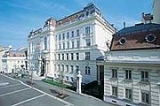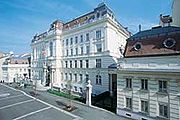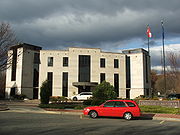
Austria–United States relations
Encyclopedia


Austria
Austria , officially the Republic of Austria , is a landlocked country of roughly 8.4 million people in Central Europe. It is bordered by the Czech Republic and Germany to the north, Slovakia and Hungary to the east, Slovenia and Italy to the south, and Switzerland and Liechtenstein to the...
and the United States
United States
The United States of America is a federal constitutional republic comprising fifty states and a federal district...
.
The U.S. Embassy in Austria
Embassy of the United States in Vienna
The United States Embassy in Vienna is the main United States diplomatic mission to Austria. The embassy building is located at Boltzmanngasse 16, Alsergrund, Vienna....
is located in Vienna
Vienna
Vienna is the capital and largest city of the Republic of Austria and one of the nine states of Austria. Vienna is Austria's primary city, with a population of about 1.723 million , and is by far the largest city in Austria, as well as its cultural, economic, and political centre...
. Since June 2009, the U.S. Ambassador-designate to Austria
United States Ambassador to Austria
This is a list of Ambassadors of the United States to Austria.The United States first established diplomatic relations with Austria in 1838 during the time of the Austrian Empire. Relations between the United States have been continuous since that time except for two interruptions during World War...
is William Eacho, III
William Eacho
William Carlton Eacho, III is the United States Ambassador to Austria. Eacho was nominated by President Barack Obama in June 2009. He was confirmed by the US Senate and sworn in in August 2009. He succeeded David F...
.
The Austrian Embassy in the U.S. is located in Washington, D.C.
Washington, D.C.
Washington, D.C., formally the District of Columbia and commonly referred to as Washington, "the District", or simply D.C., is the capital of the United States. On July 16, 1790, the United States Congress approved the creation of a permanent national capital as permitted by the U.S. Constitution....
.
History
The United States played an important role in Austria's reconstruction after World War IIWorld War II
World War II, or the Second World War , was a global conflict lasting from 1939 to 1945, involving most of the world's nations—including all of the great powers—eventually forming two opposing military alliances: the Allies and the Axis...
(Marshall Plan
Marshall Plan
The Marshall Plan was the large-scale American program to aid Europe where the United States gave monetary support to help rebuild European economies after the end of World War II in order to combat the spread of Soviet communism. The plan was in operation for four years beginning in April 1948...
) and in the Austrian State Treaty
Austrian State Treaty
The Austrian State Treaty or Austrian Independence Treaty re-established Austria as a sovereign state. It was signed on May 15, 1955, in Vienna at the Schloss Belvedere among the Allied occupying powers and the Austrian government...
.
Vienna has frequently been chosen as the venue of key superpower summit meetings, like the Vienna summit
Vienna summit
The Vienna summit was a summit meeting held on June 4, 1961 in Vienna, Austria between President John F. Kennedy of the United States and Premier Nikita Khrushchev of the Soviet Union. The leaders of the two superpowers of the Cold War era discussed numerous issues in the relationship between their...
in June 1961, with U.S. President
President of the United States
The President of the United States of America is the head of state and head of government of the United States. The president leads the executive branch of the federal government and is the commander-in-chief of the United States Armed Forces....
John F. Kennedy
John F. Kennedy
John Fitzgerald "Jack" Kennedy , often referred to by his initials JFK, was the 35th President of the United States, serving from 1961 until his assassination in 1963....
and Soviet Premier
Premier of the Soviet Union
The office of Premier of the Soviet Union was synonymous with head of government of the Union of Soviet Socialist Republics . Twelve individuals have been premier...
Nikita Khrushchev
Nikita Khrushchev
Nikita Sergeyevich Khrushchev led the Soviet Union during part of the Cold War. He served as First Secretary of the Communist Party of the Soviet Union from 1953 to 1964, and as Chairman of the Council of Ministers, or Premier, from 1958 to 1964...
, or the SALT II
Strategic Arms Limitation Talks
The Strategic Arms Limitation Treaty refers to two rounds of bilateral talks and corresponding international treaties involving the United States and the Soviet Union—the Cold War superpowers—on the issue of armament control. There were two rounds of talks and agreements: SALT I and SALT...
agreement in June 1979, with U.S. President
President of the United States
The President of the United States of America is the head of state and head of government of the United States. The president leads the executive branch of the federal government and is the commander-in-chief of the United States Armed Forces....
Jimmy Carter
Jimmy Carter
James Earl "Jimmy" Carter, Jr. is an American politician who served as the 39th President of the United States and was the recipient of the 2002 Nobel Peace Prize, the only U.S. President to have received the Prize after leaving office...
and Soviet General Secretary
General Secretary of the Communist Party of the Soviet Union
General Secretary of the Central Committee of the Communist Party of the Soviet Union was the title given to the leader of the Communist Party of the Soviet Union. With some exceptions, the office was synonymous with leader of the Soviet Union...
Leonid Brezhnev
Leonid Brezhnev
Leonid Ilyich Brezhnev – 10 November 1982) was the General Secretary of the Central Committee of the Communist Party of the Soviet Union , presiding over the country from 1964 until his death in 1982. His eighteen-year term as General Secretary was second only to that of Joseph Stalin in...
.
In February 1984, the President of Austria
President of Austria
The President of Austria is the federal head of state of Austria. Though theoretically entrusted with great power by the constitution, in practice the President acts, for the most part, merely as a ceremonial figurehead...
Rudolf Kirchschläger
Rudolf Kirchschläger
Rudolf Kirchschläger was an Austrian diplomat, politician, judge and, from 1974 to 1986, the eighth President of Austria.-Education and early life:...
paid a state visit
State visit
A state visit is a formal visit by a foreign head of state to another nation, at the invitation of that nation's head of state. State visits are the highest form of diplomatic contact between two nations, and are marked by ceremonial pomp and diplomatic protocol. In parliamentary democracies, heads...
to the United States. It was the first state visit of an Austrian President to the United States.
In September 1995, U.S. President
President of the United States
The President of the United States of America is the head of state and head of government of the United States. The president leads the executive branch of the federal government and is the commander-in-chief of the United States Armed Forces....
Bill Clinton
Bill Clinton
William Jefferson "Bill" Clinton is an American politician who served as the 42nd President of the United States from 1993 to 2001. Inaugurated at age 46, he was the third-youngest president. He took office at the end of the Cold War, and was the first president of the baby boomer generation...
invited the President of Austria
President of Austria
The President of Austria is the federal head of state of Austria. Though theoretically entrusted with great power by the constitution, in practice the President acts, for the most part, merely as a ceremonial figurehead...
Thomas Klestil
Thomas Klestil
Thomas Klestil was an Austrian diplomat and politician. He was elected the tenth President of Austria in 1992 and was re-elected to the position in 1998...
for a working visit to Washington, D.C.
Washington, D.C.
Washington, D.C., formally the District of Columbia and commonly referred to as Washington, "the District", or simply D.C., is the capital of the United States. On July 16, 1790, the United States Congress approved the creation of a permanent national capital as permitted by the U.S. Constitution....
, which took place on October 19.
On June 21, 2006, U.S. President
President of the United States
The President of the United States of America is the head of state and head of government of the United States. The president leads the executive branch of the federal government and is the commander-in-chief of the United States Armed Forces....
George W. Bush
George W. Bush
George Walker Bush is an American politician who served as the 43rd President of the United States, from 2001 to 2009. Before that, he was the 46th Governor of Texas, having served from 1995 to 2000....
held bilateral talks with the President of Austria
President of Austria
The President of Austria is the federal head of state of Austria. Though theoretically entrusted with great power by the constitution, in practice the President acts, for the most part, merely as a ceremonial figurehead...
Heinz Fischer
Heinz Fischer
Heinz Fischer GColIH is the President of Austria. He took office on 8 July 2004 and was re-elected for a second and last term on 25 April 2010. Before he took office, Fischer was a member of the Social Democratic Party of Austria...
at the Hofburg Imperial Palace
Hofburg Imperial Palace
Hofburg Palace is a palace located in Vienna, Austria, that has housed some of the most powerful people in Austrian history, including the Habsburg dynasty, rulers of the Austro-Hungarian empire. It currently serves as the official residence of the President of Austria...
in Vienna
Vienna
Vienna is the capital and largest city of the Republic of Austria and one of the nine states of Austria. Vienna is Austria's primary city, with a population of about 1.723 million , and is by far the largest city in Austria, as well as its cultural, economic, and political centre...
, together with U.S. Secretary of State
United States Secretary of State
The United States Secretary of State is the head of the United States Department of State, concerned with foreign affairs. The Secretary is a member of the Cabinet and the highest-ranking cabinet secretary both in line of succession and order of precedence...
Condoleezza Rice
Condoleezza Rice
Condoleezza Rice is an American political scientist and diplomat. She served as the 66th United States Secretary of State, and was the second person to hold that office in the administration of President George W. Bush...
and Foreign Minister of Austria
Foreign Minister of Austria
The Foreign Minister of Austria is responsible for handling Austria's foreign policy.-Under the First Austrian Republic:* Victor Adler* Otto Bauer* Karl Renner* Michael Mayr* Johann Schober* Walter Breisky* Leopold Hennet* Alfred Grünberger...
Ursula Plassnik
Ursula Plassnik
Ursula Plassnik is an Austrian diplomat and politician. She was Foreign Minister of Austria between October 2004 and December 2008.-Early life and career:...
, shortly before a US-European Union summit.

